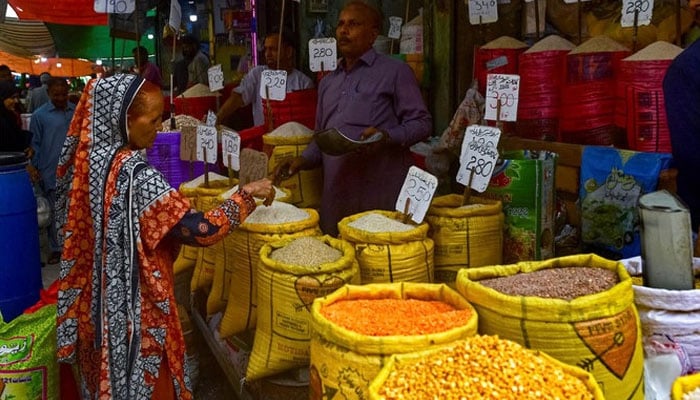
- The drop represents the lowest inflation rate since October 2014.
- Experts attribute much of the decline in inflation to a high base effect.
- The sensitive price indicator shows a decline of 0.65% compared to the previous week.
Inflation in Pakistan saw a sharp decline, falling to 1.8% year-on-year for the week ending January 9, compared to 3.97% observed the previous week.
This is the lowest inflation rate since October 2014, a remarkable change from the staggering peak of 48.35% reached in May 2023, according to data from the Pakistan Bureau of Statistics (PBS).
The decline in inflation is largely attributed to a high base effect, according to independent economists. They say that even though the numbers are improving, the average consumer continues to feel the effects.
The Sensitive Price Indicator (SPI), which tracks the cost of essential goods, showed a decline of 0.65 percent from the previous week, indicating a mixed trend in prices of 51 items monitored across 17 cities. Of the items tracked, 18 saw their prices increase, while 10 saw a decrease and 23 remained unchanged.
Notably, tomatoes fell by 31.4% and potatoes by 10.4%. Other reductions included eggs down 6%, pulses grams down 1.64%, onions down 0.87%, broken basmati rice down 0.54%, IRRI-6/9 rice down 0, 40% and the legume puree of 0.27%.
While cooking oil and sugar recorded modest increases of 1.56% and 1.23% respectively. Prices of chicken, vegetable ghee, bread, laundry soap, garlic and firewood also increased, but by less than 1% compared to the previous week.
Economists predict that the decline in the SPI could lead to a sharp reduction in consumer price index (CPI) inflation for January 2025, with estimates ranging between 2.5% and 3%, down from 4.1 % in December 2024. This trend could prompt the central bank to consider a cut of around 1.5% in the discount rate by the end of this month. Currently, the key rate is 13%.
SPI data also revealed disparities in the impact of inflation on different income groups. Households earning less than Rs 17,732 per month faced a price increase of 1.44% year-on-year, while those with monthly incomes above Rs 44,175 saw an increase of 2.22%.
According to the SPI bulletin, among the products that saw the biggest weekly decline, tomatoes saw a sharp drop of 31.4%, while potatoes became cheaper by 10.4%. Other food items whose prices fell included eggs, which fell 6%.
A review of the SPI bulletin shows that inflation has affected households differently. The lowest income group, earning less than Rs 17,732 per month, faced a price increase of 1.44% year-on-year. On the other hand, households earning more than Rs 44,175 per month saw an increase of 2.22%.
Despite the overall decline, several essential products have seen substantial price increases over the past year. Ladies’ sandals jumped 75%, while potatoes and pulses rose 59% and 42% respectively.
Similarly, the price of moong pulses increased by 34%, milk powder by 26%, beef by 24% and garlic by 18%. Gas charges for the least consuming slabs increased by 15.5%, vegetable ghee by 15.5%, cooked daal by 15%, liners by 14.4% and firewood by 13% as of during the past year.
Conversely, some products such as onions and wheat flour saw significant price drops of 36% each. Prices of eggs and chili powder fell 24% and 20%, respectively. Electricity rates for the least consuming slab decreased by 18.1%.
Other items that became cheaper include masoor pulses by 11.2%, broken basmati rice by 9.1%, pulse puree by 7.0%, diesel by 6.4%, bread by 5.5% and gasoline 5.45%.
